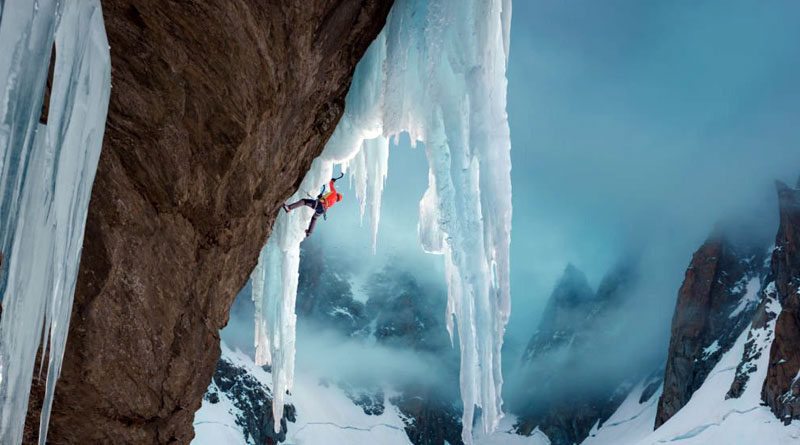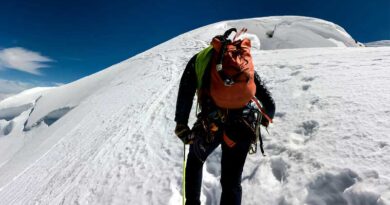Is Ice Climbing Dangerous?
Yes, ice climbing can be dangerous. It involves scaling frozen waterfalls, cliffs, and other icy formations using specialized gear, such as crampons, ice axes, and ropes. Ice climbing takes place in a cold, wet, and often remote environment, where the terrain and conditions can be unpredictable and hazardous.
You face a range of dangers, including falls, avalanches, ice collapses, hypothermia, and frostbite. The risk of injury or death can be mitigated by proper training, equipment, and planning, as well as by understanding and respecting the environment and the conditions.
Ice climbing should only be attempted by experienced climbers who have received proper training, and who are equipped with the appropriate gear and safety equipment. Climbers should always check the weather and ice conditions before heading out and should be prepared to turn back or change their plans if conditions become too dangerous.
Dangers of Ice Climbing
Ice climbing is an extreme sport that requires considerable skill, preparation, and caution. While ice climbing can be a thrilling and rewarding activity, there are numerous dangers that climbers must be aware of. Falls, avalanches, ice collapses, hypothermia, and frostbite are among the dangers.
Hazards ice climbers face
Avalanches are a major risk for ice climbers, especially in areas with steep slopes or unstable snowpacks. Avalanches can be caused by a number of factors, including temperature, precipitation, and wind. They are especially dangerous for ice climbers because they can bury them beneath a layer of snow and ice.
Statistics on injury and mortality rates
According to American Alpine Club statistics, ice climbing has a higher injury and mortality rate than many other types of climbing. Ice climbing injuries can range from minor cuts and bruises to more serious injuries like broken bones, head injuries, and internal bleeding. Ice climbing accidents can be fatal in extreme cases.
Examples of notable accidents
Over the years, there have been several notable ice climbing accidents, including the 2002 accident on Mount Hood in Oregon, in which three climbers died after falling into a crevasse. A well-known Canadian ice climber died in 2014 after falling off a route he had climbed many times before. These incidents serve as a reminder of the inherent dangers of ice climbing, as well as the importance of proper planning and caution.
Preparation
Ice climbing is an extreme sport that requires a high level of preparation and skill.
Importance of proper training and experience
Ice climbing requires proper training and experience to be safe and successful. You should begin with basic rock climbing and mountaineering before progressing to ice climbing. This will assist you in developing skills such as rope handling, anchor building, and route finding.
Required gear and equipment
You must have the proper gear and equipment in addition to training. Crampons, ice axes, ropes, and helmets are among the necessary equipment. Crampons are spikes attached to the bottom of the boots that provide traction on the ice. In the event of a fall, ice axes are used for balance and self-arrest. Ropes are used to protect climbers and anchor them to the ice. Helmets are required for protection from falling ice and rocks.
Tips for choosing appropriate routes and conditions
Choosing the right route and conditions is also important for safe ice climbing. Be aware of the weather and the ice’s stability. Climbing on thin or unstable ice is dangerous because it can collapse or break. You should also be aware of the slope’s angle, as steeper slopes are more vulnerable to avalanches.
Ice climbing can be physically demanding, so you should be in good physical condition before attempting it. You should also be prepared for the cold, wet, and often remote environment of ice climbing. Proper clothing, such as insulated layers and waterproof gear, is essential for staying warm and dry.
Safety Precautions
Ice climbing can be a dangerous activity, but there are several safety measures that you can take to minimize the risks.
Use anchors
One of the most important safety measures is to use anchors. Anchors are used to secure the climber and prevent falls. They can be made from ice screws, rock anchors, or other types of equipment.
Check for unstable ice
You should also be aware of the stability of the ice. Check for signs of unstable ice, such as cracks or hollow sounds. Also, also avoid climbing on thin or melting ice, as it can break or collapse.
Avoid avalanche-prone areas
Another hazard is avalanches. You should be aware of the avalanche danger rating in the area and avoid climbing in avalanche-prone areas. You should also carry avalanche safety equipment, such as a beacon, shovel, and probe, and know how to use them in the event of an avalanche.
Self-arrest and rescue techniques
In the event of a fall, you should know how to perform self-arrest and rescue techniques. Self-arrest is a technique used to stop a fall by digging the ice axe into the ice and using it as an anchor. Rescue techniques include methods for pulling a fallen climber back up to the surface or providing first aid.
It is also important to communicate with your partners and stay within sight and sound of each other. Have a plan for emergencies and know how to contact emergency services.
Conclusion
To summarize, ice climbing is an extreme sport with inherent dangers. These risks, however, can be reduced with proper planning and precautions. To ensure a safe and successful climb, ice climbers should have the necessary training, equipment, and preparation. They should be aware of the potential hazards, such as unstable ice and avalanches, and take the necessary precautions to avoid them. Climbers should be familiar with self-arrest and rescue techniques and have a plan in place to contact emergency services in the event of an emergency. With these precautions in place, ice climbers can enjoy the thrill and beauty of this difficult sport while minimizing risks.




